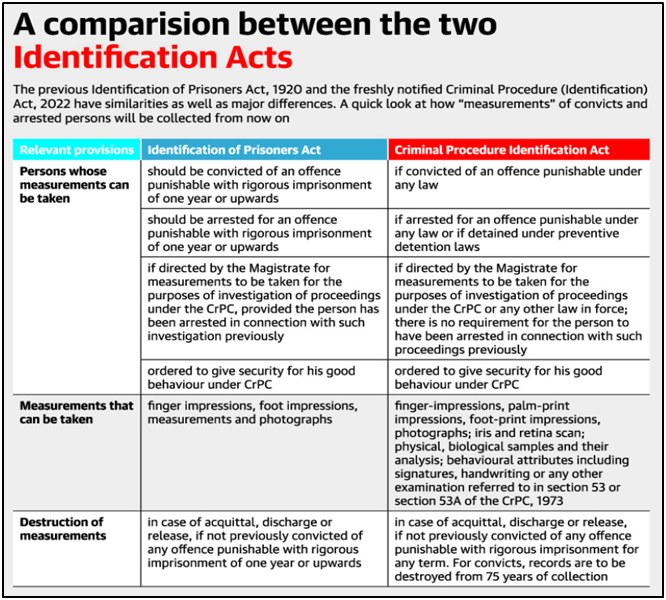Why in News?
- The CrPI Act 2022 enables police and central investigating agencies to collect, store and analyse physical and biological samples including retina and iris scans of arrested persons.
- Though the rules that would govern the Act were notified, the Act is yet to be implemented fully as the nodal agency - NCRB, is still preparing the guidelines and SOP to implement the legislation.
What’s in Today’s Article?
- Why was the Criminal Procedure (Identification) Act (CrPI) Brought In?
- What is the role of the National Crime Records Bureau (NCRB)?
- What are the Challenges in the Implementation of the CrPI Act?
- Way Ahead and Conclusion
Why was the Criminal Procedure (Identification) Act (CrPI) Brought In?

- The CrPI Act repealed the British-era Identification of Prisoners Act 1920 whose scope was limited to -
- Collecting and recording finger impressions, footprint impressions and photographs of certain category of convicted persons and
- Impressions of non-convicted persons on the orders of a Magistrate.
- The new Act made provisions for the use of modern techniques to capture and record appropriate body measurements.
What is the role of the National Crime Records Bureau (NCRB)?
- The central body - NCRB, which operates under the Union Ministry of Home Affairs (MHA), has been entrusted with the task to store, process, share, disseminate and destroy records of measurements.
- Impressions taken at any police station will be stored in a common database maintained by the NCRB.
- The database could be accessed by authorised police and prison officials across the country.
- The NCRB will prescribe -
- The specifications of the equipment or devices to be used for taking measurements in digital and physical format,
- The method of handling and storing measurements by the State police in a format compatible with the NCRB database and
- Also, the information technology system to be used for taking the measurements.
- Police and prison officials have been authorised to take measurements and the Act expanded the scope to also allow -
- Any person skilled in taking the measurements or
- A registered medical practitioner or
- Any person authorised to take such measurements.
- The records are to be stored for 75 years.
What are the Challenges in the Implementation of the CrPI Act?
- Collection of DNA samples: Though the Act and rules do not distinctly mention collection of DNA samples and face-matching procedures, the NCRB has said that these measures will be rolled out in around 1,300 locations across the country.
- Also, the type of DNA samples that could be collected by the police have not been defined yet.
- Shortage of devices:
- Police across States have been trained to record finger impressions through the National Automated Fingerprint Identification System (NAFIS).
- NAFIS, also under the NCRB, is a separate project that was launched in 2022.
- It assigns a unique 10-digit National Fingerprint Number (NFN) to all suspects arrested by the police.
- NAFIS integrates the data on a common platform, enabling the police to run a countrywide search to match fingerprint impressions lifted from a crime scene.
- However, several police officials said the iris scanners and devices that would enable capturing of DNA and facial-recognition systems are yet to be provided.
- Violates fundamental rights, including the right to privacy: With plans to include DNA samples and facial-recognition technology, questions arose about the protection of such data.
- Lack of awareness: Though the rules state that measurement of persons detained or arrested under prohibitory and preventive sections of law are not to be recorded, not many officers are aware of it.
- Onus of destruction and disposal of records on an individual falsely implicated: For such a disposal/destruction, the request will have to be made to the nodal officer.
- This would impact people from sections of society who do not have access to the law and would therefore be unable to apply for deletion.
Way Ahead and Conclusion:
- The provision should be read in terms of the Right to be Forgotten and should not be at the mere discretion of the Nodal Officer.
- Handling DNA samples requires proper training and the misuse of the database can be prevented by ensuring identification and deployment of appropriate safeguards allowing only designated officials to access the data in real time.
- Issue of connectivity must be addressed because police in smaller States have been unable to fulfil the requirement of secured Internet leased lines.
- According to the Central government, the privacy and data protection related concerns are addressed in the Rules formulated under the legislation and through model Prison Manuals that States can refer to.
- The immediate future of this law is unclear. A writ petition has been filed challenging the constitutionality of the law before the Delhi HC. The court has issued notice to the Central government for filing a reply.









